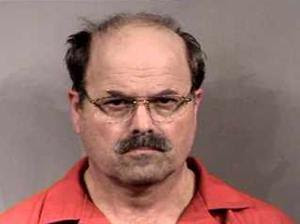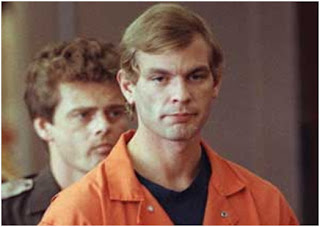Notable Quotable
“I love to kill people. I love watching them die. I would shoot them in the head and they would wiggle and squirm all over the place, and then just stop. Or cut them with a knife and watch their faces turn real white. I love all that blood. I told one lady to give me all her money. She said no, so I cut her and pulled her eyes out.”
—Richard Ramírez
In 1983, there were five serial murders at large in Los Angeles, but the most terrifying of all was the one the media dubbed the “Night Stalker.” He was terrifying—his MO was to invade homes in the middle of the night and leave dead bodies and blood all over the place when he left. He was responsible for the deaths of at least sixteen people.
As is so common with serial killers, the extent of the danger was not known in the beginning. The first victim was a seventy-nine-year-old woman in Glassell Park in June 1984. Eight months later, a six-year-old Montebello girl was abducted from a bus stop and her sexually abused body was found in Silver Lake on February 25. The next victim of the Night Stalker was a nine-year-old girl, and for some reason, his pattern differed with this crime. He abducted her from her
bedroom, raped her, and dropped her in Elysian Park.
On March 17, the Night Stalker began a horrifying murder spree, entering the condo of thirty-four-year-old Dayle Okazaki and Mara Hernandez, shooting Okazaki to death and wounding Hernandez. In Monterey Park he pulled thirty-year-old Tsa Lian Yu from her car and shot her multiple times. Yu died the next day, while the Night Stalker was in the middle of abducting and raping a girl from Eagle Rock.
But something good for the police came out of this spree of violence. Hernandez, who survived, was able to provide a description of the killer. She described him as having a long, gaunt face, black stringy hair, and wide-spaced teeth that were brown and rotted out, which ultimately would be traced to the killer’s subsisting on candy. The police were still playing their cards close to the vest, not saying whether the murders were related.
Things got weirder when the Night Stalker invaded the home of Vincent Zazzara and his wife, Maxine, on March 27. Zazzara was pummeled to death and his wife stabbed to death, but the killer also cut out the eyes of the woman and left with them.
Next, William Doi of Monterey Park was shot in the head, but his dying action of calling the police saved his wife. Over the summer, the Night Stalker killed eight more people of varying ages.
On August 6, Christopher Peterson and his wife, Virginia, were wounded in their Northridge home. And then there were two more killings, and the description of the killer matched the description the Petersons had given of their attacker. The police finally announced they were looking for a serial killer who was responsible for a lot of murders.
As is so common with serial killers, the extent of the danger was not known in the beginning. The first victim was a seventy-nine-year-old woman in Glassell Park in June 1984. Eight months later, a six-year-old Montebello girl was abducted from a bus stop and her sexually abused body was found in Silver Lake on February 25. The next victim of the Night Stalker was a nine-year-old girl, and for some reason, his pattern differed with this crime. He abducted her from her
bedroom, raped her, and dropped her in Elysian Park.
On March 17, the Night Stalker began a horrifying murder spree, entering the condo of thirty-four-year-old Dayle Okazaki and Mara Hernandez, shooting Okazaki to death and wounding Hernandez. In Monterey Park he pulled thirty-year-old Tsa Lian Yu from her car and shot her multiple times. Yu died the next day, while the Night Stalker was in the middle of abducting and raping a girl from Eagle Rock.
But something good for the police came out of this spree of violence. Hernandez, who survived, was able to provide a description of the killer. She described him as having a long, gaunt face, black stringy hair, and wide-spaced teeth that were brown and rotted out, which ultimately would be traced to the killer’s subsisting on candy. The police were still playing their cards close to the vest, not saying whether the murders were related.
Things got weirder when the Night Stalker invaded the home of Vincent Zazzara and his wife, Maxine, on March 27. Zazzara was pummeled to death and his wife stabbed to death, but the killer also cut out the eyes of the woman and left with them.
Next, William Doi of Monterey Park was shot in the head, but his dying action of calling the police saved his wife. Over the summer, the Night Stalker killed eight more people of varying ages.
On August 6, Christopher Peterson and his wife, Virginia, were wounded in their Northridge home. And then there were two more killings, and the description of the killer matched the description the Petersons had given of their attacker. The police finally announced they were looking for a serial killer who was responsible for a lot of murders.
Then the Night Stalker traveled to San Francisco, and on August 17 broke into the home of Peter and Barbara Pan. Peter was shot and killed, but his wife survived the shooting and provided sketches to police of the Night Stalker.
Then, a big break came. In Mission Viejo on August 22, twenty-nine-year-old Bill Carns was shot in the head and his fiancée raped, and the Night Stalker drove away in their car. The car was abandoned and recovered by the police along with fingerprints. The prints lead police to twenty-five-year-old Richard Ramírez, who was from Texas and had compiled a lengthy rap sheet for drug offenses. Police questioned people who knew him and learned that he was an avowed satanist who was crazed about the music group AC/DC; and one of the bands songs, “Night Prowler,” had become a sort of anthem for Ramírez.
The police spread his picture everywhere, and now the citizenry had a face to go along with the nickname. Foolishly, Ramírez stayed in Los Angeles, where he had committed most of the murders. He wandered into East Los Angeles, where he was identified by Hispanic locals as he tried to steal a car and was run down and half beaten to death before police, who had been summoned, saved his life. He was held in jail and charged with fourteen counts of murder.
Monster Beginnings
A look at his background indicates that Ramírez certainly had the right childhood environment to produce a killer. He was the youngest of five children in a Mexican American family that had immigrated to the United States. His father was a volatile man with a terrible temper. Richard kept to himself but when he was very young—in just the eighth grade, he started using marijuana and snuffing glue, obviously as anesthetics for living in a household where his father was such an unpredictable and disruptive force.
He attended Theodore Roosevelt High School in the Boyle Height section of Los Angeles but quit in the ninth grade. His diet at that time, which was to lead to the horrendous condition of his teeth, was junk food. It was a diet so rich in sugar that it rotted his teeth and made his breath foul. He continued to smoke marijuana and chalked up his first arrest for drug possession. He was also was stealing and was arrested twice for stealing cars: first in Pasadena in 1981 and then in Los Angeles in 1984.
Richard’s association with his cousin Mike aided his development into a madman. Mike was a Vietnam vet and member of the Special Forces, who showed Richard pictures of the killing and torture of Vietnamese women. Ultimately, Mike murdered his wife while the twelve-year-old Ramírez watched, an event that had a profoundly negative effect on Ramírez.
A look at his background indicates that Ramírez certainly had the right childhood environment to produce a killer. He was the youngest of five children in a Mexican American family that had immigrated to the United States. His father was a volatile man with a terrible temper. Richard kept to himself but when he was very young—in just the eighth grade, he started using marijuana and snuffing glue, obviously as anesthetics for living in a household where his father was such an unpredictable and disruptive force.
He attended Theodore Roosevelt High School in the Boyle Height section of Los Angeles but quit in the ninth grade. His diet at that time, which was to lead to the horrendous condition of his teeth, was junk food. It was a diet so rich in sugar that it rotted his teeth and made his breath foul. He continued to smoke marijuana and chalked up his first arrest for drug possession. He was also was stealing and was arrested twice for stealing cars: first in Pasadena in 1981 and then in Los Angeles in 1984.
Richard’s association with his cousin Mike aided his development into a madman. Mike was a Vietnam vet and member of the Special Forces, who showed Richard pictures of the killing and torture of Vietnamese women. Ultimately, Mike murdered his wife while the twelve-year-old Ramírez watched, an event that had a profoundly negative effect on Ramírez.
Afterword
Ramírez’s trial, which started on July 22, 1988, took a full year. Finally, on September 30, 1989, he was found guilty of thirteen counts of murder and thirty assorted felonies. On November 7, 1989, he was sentenced to death. Ramírez didn’t care. He said in court: “You maggots make me sick. You don’t understand me. I am beyond good and evil. I will be avenged. Lucifer dwells in us all.”
Ramírez’s trial, which started on July 22, 1988, took a full year. Finally, on September 30, 1989, he was found guilty of thirteen counts of murder and thirty assorted felonies. On November 7, 1989, he was sentenced to death. Ramírez didn’t care. He said in court: “You maggots make me sick. You don’t understand me. I am beyond good and evil. I will be avenged. Lucifer dwells in us all.”










